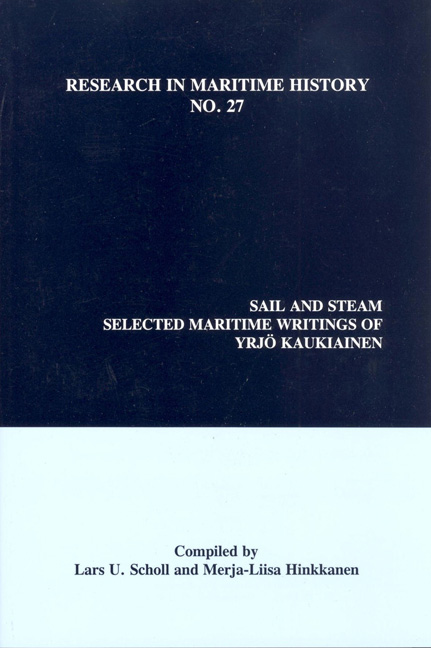Book contents
- Frontmatter
- Frontispiece
- Table of Contents
- Acknowledgements
- “Yrjö Kaukiainen: A Tribute on the Occasion of his Forthcoming Retirement as Professor of Maritime History at the University of Helsinki”
- “Yrjö Kaukiainen: A Man of the Sea”
- “Yrjö Kaukiainen and the Development of Maritime Economic History”
- “Finnish Sailors, 1750-1870”
- “Finnish and International Maritime Labour in the Age of Sail: Was There a Market?”
- “Five Years before the Mast: Observations on the Conditions of Maritime Labour in Finland and Elsewhere”
- “The Maritime Labour Market: Skill and Experience as Factors of Demand and Supply”
- “Owners and Masters: Management and Managerial Skills in the Finnish Ocean-Going Merchant Fleet, c. 1840-1880”
- “From Low-Cost to High-Cost Shipping: Finnish Maritime Labour Costs after the Second World War”
- “The Modernization of Finnish Coastal Shipping and Railway Competition c. 1830-1913”
- “British Timber Imports and Finnish Shipping 1860-1910”
- “Baltic Timber-Trade under Sail: An Example of the Persistence of Old Techniques”
- “Coal and Canvas: Aspects of the Competition between Steam and Sail, c. 1870-1914”
- “Dutch Shipping and the Swedish Navigation Act (1724). A Case Study”
- “Seamen Ashore: Port Visits of Late Nineteenth-Century Finnish Sailors”
- “Wreck-plundering by East Finnish Coastal People - Criminal Tradition or Popular Culture?”
- “From Days and Knots to Pounds and Dollars: Some Problems in the Study of the Economics of Late Nineteenth Century Merchant Shipping”
- “Tons and Tonnages: Ship Measurement and Shipping Statistics, c. 1870-1980”
- “International Freight Markets in the 1830s and 1840s: The Experience of a Major Finnish Shipowner”
- “Shrinking the World: Improvements in the Speed of Information Transmission, c. 1820-1870”
- “Yrjö Kaukiainen: A Maritime Bibliography”
“The Modernization of Finnish Coastal Shipping and Railway Competition c. 1830-1913”
- Frontmatter
- Frontispiece
- Table of Contents
- Acknowledgements
- “Yrjö Kaukiainen: A Tribute on the Occasion of his Forthcoming Retirement as Professor of Maritime History at the University of Helsinki”
- “Yrjö Kaukiainen: A Man of the Sea”
- “Yrjö Kaukiainen and the Development of Maritime Economic History”
- “Finnish Sailors, 1750-1870”
- “Finnish and International Maritime Labour in the Age of Sail: Was There a Market?”
- “Five Years before the Mast: Observations on the Conditions of Maritime Labour in Finland and Elsewhere”
- “The Maritime Labour Market: Skill and Experience as Factors of Demand and Supply”
- “Owners and Masters: Management and Managerial Skills in the Finnish Ocean-Going Merchant Fleet, c. 1840-1880”
- “From Low-Cost to High-Cost Shipping: Finnish Maritime Labour Costs after the Second World War”
- “The Modernization of Finnish Coastal Shipping and Railway Competition c. 1830-1913”
- “British Timber Imports and Finnish Shipping 1860-1910”
- “Baltic Timber-Trade under Sail: An Example of the Persistence of Old Techniques”
- “Coal and Canvas: Aspects of the Competition between Steam and Sail, c. 1870-1914”
- “Dutch Shipping and the Swedish Navigation Act (1724). A Case Study”
- “Seamen Ashore: Port Visits of Late Nineteenth-Century Finnish Sailors”
- “Wreck-plundering by East Finnish Coastal People - Criminal Tradition or Popular Culture?”
- “From Days and Knots to Pounds and Dollars: Some Problems in the Study of the Economics of Late Nineteenth Century Merchant Shipping”
- “Tons and Tonnages: Ship Measurement and Shipping Statistics, c. 1870-1980”
- “International Freight Markets in the 1830s and 1840s: The Experience of a Major Finnish Shipowner”
- “Shrinking the World: Improvements in the Speed of Information Transmission, c. 1820-1870”
- “Yrjö Kaukiainen: A Maritime Bibliography”
Summary
In the Finnish context, a fairly natural domain for coastal shipping consisted of the waters of the Gulf of Finland and Bothnia as well as of the northern Baltic, roughly north of fifty-nine degrees, or the latitude of Stockholm. In navigational sense, of course, one could claim that an even wider definition might be relevant. Long trips could be made across the Baltic without losing visual contact with the coastline. In practice, however, such small Finnish tonnage as can be termed »coastal* only very seldom sailed beyond Stockholm or the northwestern tip of the Estonian coast. Thus, in this article, coastal shipping is understood to be almost synonymous with the term cabotage (that is, coastal traffic between ports of one country, domestic traffic), which the addition of the most proximate coasts of Sweden, Russia and Estonia.
Finland was a country with fairly small regional variances in economic structure, at least as far as coastal districts were concerned. Although commerce was the sole privilege of towns until the 1850s, there were no really large urban centres which attracted primary products or labour from large rural areas. Just as the classic law of comparative advantage predicts, the main part of the commerce of coastal towns (whether in terms of bulk or value) consisted of trade with foreign places, involving more or less extended direct shipping. Accordingly, the demand for domestic coastwise maritime transport between Finnish urban sites was fairly small until the middle of the nineteenth century. There was some transport of iron manufacturers from south Finnish ironworks, of limestone from the few localities where it was to be found, and of firewood and fish plus certain other food products from archipelagoes to larger towns. Only when we look at shipping crossing over to Sweden, Estonia and northwest Russia do we find maritime transport on a larger scale. Above all, there was a massive trade in firewood to Stockholm and St. Petersburg and return loads of iron ore from the Stockholm archipelago (Utö) to Finnish south-coast ironworks, mainly carried on by coastal peasant vessels. Traditionally, there was also the all-important shipping of tar from Ostrobothnia to Stockholm, which mainly took place on urban-owned tonnage. When Finland was ceded to Russia in 1809, tar shipments to Stockholm diminished rapidly and, more gradually, even ore imports declined after the 1840s.
- Type
- Chapter
- Information
- Sail and SteamSelected Maritime Writings of Yrjö Kaukiainen, pp. 79 - 90Publisher: Liverpool University PressPrint publication year: 2004



